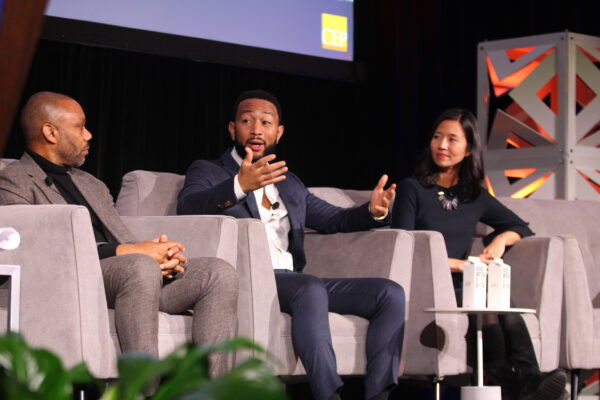“Wait for that wisest of all counselors, Time.” ~ Pericles
In a recent press conference, Federal Reserve Chair Janet Yellen indicated that the data on inflation was on the “high side.” Then, she emphasized her belief that the data is “noisy” and that inflation remains in-line with the central bank’s expectations. It was an ironic moment because her attempt to rise above the noise served only to create an explosion of noise around her comments. Such is the nature of her job and such is the nature of Wall Street’s seemingly pervasive addiction to short-term thinking and reactions.
While Wall Street is one of the “noisiest,” most professions suffer a similar affliction. There is no shortage of chatter in philanthropy. The volume rises and falls while the content varies, evolves, and sometimes repeats over time. Buzz words come and go, often relabeling a trend or concept. An inexhaustible flow of cutting edge ideas abounds offering endless potential for what we can and should fund. This is not a negative phenomenon. Often, the noise comes from genuine excitement about the knowledge we are gaining in a still maturing field. There is a refreshing fluidity about it.
Nevertheless, we should always be mindful that the impact of our newfound knowledge should be balanced with a collective wisdom for the field. Wisdom is more fixed than fluid. It is the selective and objective application of knowledge. Wisdom allows us to rise above the noise. It emerges slowly from years of experience. Therefore, knowledge at the expense of wisdom often distracts from what matters most.
For some time, we have seen a great deal of discussion generated around “outcomes” and “evaluation.” There should be no doubt that we need to evaluate grants. Yet, as we acquire increasing knowledge of ways that grants can be monitored and measured, we would be wise to step back and evaluate the impact of our heightened evaluation efforts.
As a result, we discover the law of unintended consequences influencing grantees and ultimately the type of grants they seek from foundations. In a recent Chronicle of Philanthropy opinion piece, Arcus Foundation executive director Kevin Jennings describes honest, frightening feedback he heard from accomplished grant seekers. In explaining one of the lessons learned he writes, “Stop counting widgets. The foundation world’s obsession with quick and tangible outcomes was, in fact, perhaps the ultimate villain in our conversation. Grant makers and nonprofits alike say the tyranny of requirements to generate short-term measurable outcomes is a critical barrier to innovation.”
This strikes a nerve for several reasons. One, it further reinforces a long held suspicion that the noise around outcomes would lead to short-term thinking and a tendency to overplay outcome evaluation at the expense of process evaluation. Two, it illustrates how a push for short-term outcomes feeds the power dynamic and results in an ever more lopsided “partnership” between foundations and grantees (more on partnership can be found here). Three, it is another example of misunderstanding the nature, unpredictability and, therefore, unavoidable inefficiency that comes when trying to help people (more on this here). Finally, overplaying near-term outcomes means we risk missing out on potentially powerful long-term results.
A strong, simple lesson on the above, particularly the last point, was reinforced for me when I visited the Chesapeake Bay Foundation (CBF) in March. During the visit, I learned about a grant our foundation awarded to the CBF in 1975. It was for $35,000 (equal to about $150,000 today) to hire the CBF’s Meredith Creek Education Center’s first manager.
This initial grant was structured simply to support a clear need for a then promising, relatively young organization. At that time, demand from teachers for experiential learning was building and the concept of field experiences for school science classes was taking hold. The CBF had one employee for the entire education program who was running trips from Meredith Creek with a workboat and towing a canoe fleet to other Bay waterways to serve schools near their communities. It was not possible for one person to run the education program and take care of the Meredith Creek facility.
The hiring of the new manager allowed for further development of the program. Then, after only eighteen months, the originally funded manager left for graduate school after hiring a young intern from the University of Maryland to take over.
Let’s pause here.
Imagine how this grant would be viewed today. Even if the original manager had made considerable progress, how excited would foundations be today about a practical grant, essentially for operating support, when they find out that the manager they funded is leaving and an intern is taking over? How many would feature it on their websites? If the grant were to be paid out in installments, how many foundations would pull support? How many foundations would call into question the outcomes being reported from someone who would leave so quickly for graduate school and turn it over to an intern? If they decide not to pull funding, how many foundations would then take a prescriptive approach and try to influence the new hire by disapproving of an intern? How many might contribute additional funds to allow for a more experienced hire?
Fortunately, our foundation has a long history of avoiding prescriptive practices by having the patience and trust to let grants run their natural course, unless a grantee initiates changes based upon their lessons learned through implementation.
Back to the grant.
It turns out that the young intern was Don Baugh, who retired recently as the CBF’s vice president for education. The Meredith Creek Education Center has just celebrated its 40th anniversary. It now serves over 1,500 students, teachers, and other adults per year. Based upon the early successes at Meredith Creek, Don Baugh also expanded the education program to establish a multi-state, experiential education program that serves over 30,000 students, teachers, principals, and other adults annually.
It is amazing what time can do. What appeared to be a grant with modest near-term results turned out to be an astounding success with tremendous lasting value that continues compounding to this day.
Time is, indeed, a great counselor. Evaluation is a must but the expectation for quick results should be kept in proper perspective. The enticing “knowledge” of today might encourage many in a similar situation to pull the funds and move on to something “hot.” Yet, those that react too quickly will never know if they have missed the exponential gains that require time to accrue.
Wisdom allows philanthropy to have courage in our conviction – to resist temptation and trust in the decision process. Wisdom also engenders a very careful, balanced approach in expectations for and reactions to short-term outcomes. Finally, wisdom teaches a broader lesson that finding good people, funding them and giving them time to do what they do best trumps near-term noise. Simple? Yes. However, this is far easier said than done.
William Keator is vice president for programs at The Arthur Vining Davis Foundations. He began his career in philanthropy as the first program officer for the Jacksonville Jaguars Foundation. You can read his other posts for the CEP Blog here.



